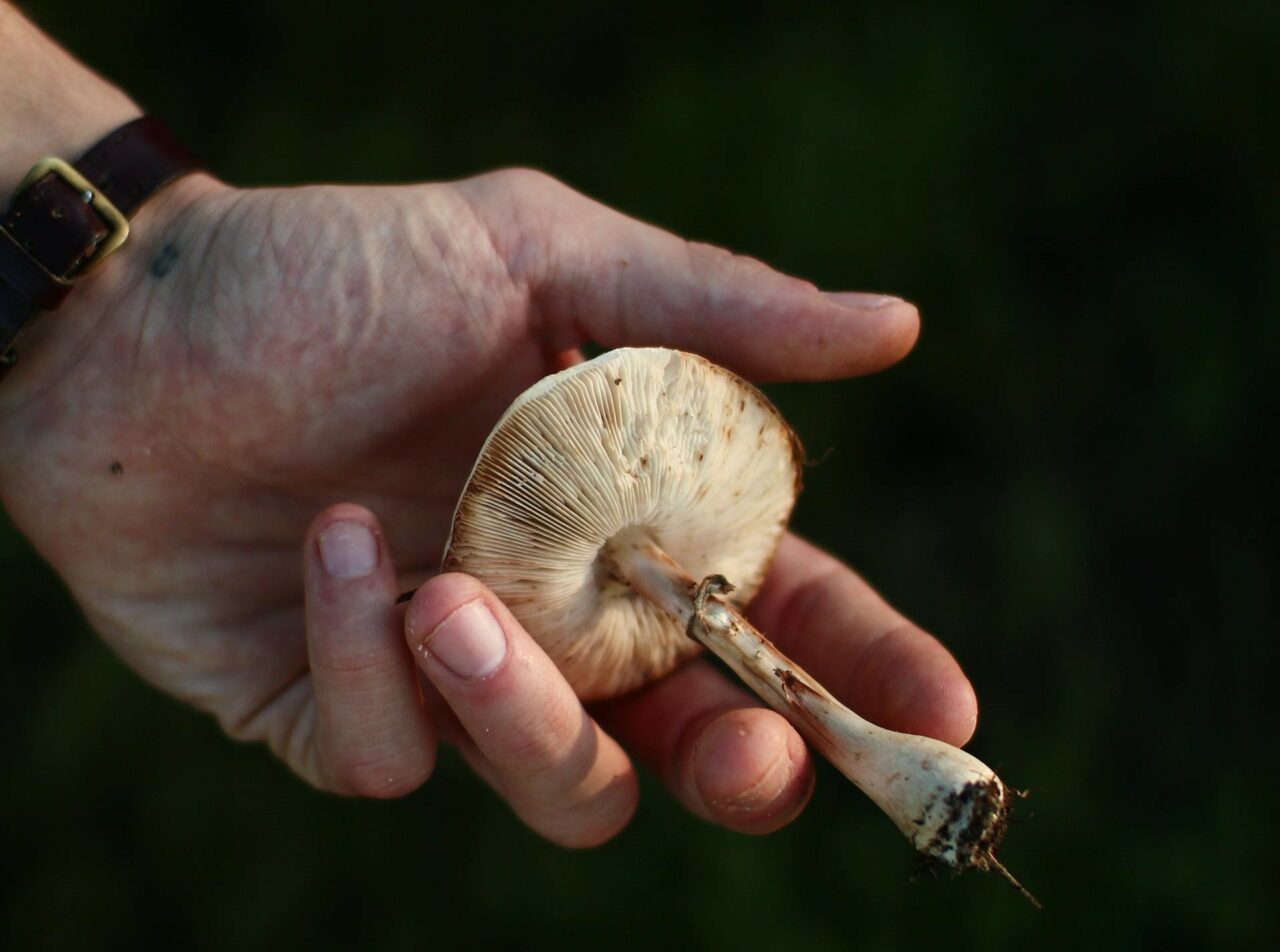Psilocybin mushrooms, traditional psychedelics that function as serotonin 5-HT2A receptor agonists, like LSD, are currently under investigation in the realm of psilocybin-supported therapy. This research is focused on a range of mental health disorders including, but not limited to, major depression-related emotional distress, anxiety, cluster headaches, and migraines.
To understand the beneficial effects of shrooms in these health issues, it’s important to delve into their metabolic processes within the body. This knowledge equips both researchers and users to understand how the active compound triggers psychological and therapeutic impacts. This article offers a basic overview of the pharmacology and pharmacokinetics of psilocybin.
[toc]
Key Points:
- Half of the psychedelic fungi ingested orally is absorbed and distributed throughout the body.
- The compound in the fungi undergoes dephosphorylation via the enzyme alkaline phosphatase, predominantly in the liver.
- Around 3.4% of the compound is expelled in its original form within 24 hours, while most of it is excreted as a stable metabolite.
What Does Pharmacokinetics Mean?
Pharmacokinetics (PK) refers to the study of how substances such as drugs are processed by the body once they are ingested. It is related but distinct from pharmacodynamics, which explores how a compound interacts with the body. PK focuses on four main elements: absorption, distribution, metabolism, and excretion (ADME).
Comprehending these processes enables healthcare practitioners to prescribe the most advantageous medications with minimum risk. It also allows for the customization of treatments based on each individual’s unique physiological and lifestyle factors.
How Does Pharmacokinetics Relate to Psilocybin?
Psilocybin and psilocin, the primary active components in specific types of magic mushrooms, have garnered significant attention from both researchers and users. Pharmacokinetics scrutinizes how the body processes mushrooms containing psilocybin, contributing to our understanding of their potential medicinal or recreational effects.
These compounds, often referred to as “magic,” “psychedelic,” “medicinal,” or “sacred,” are found in fungi that are consumed. The Mushroom species, their natural habitat, size, the environments in which they flourish and dry, as well as their age, can significantly alter their potency.
Although these mushrooms naturally exist in the wild, scientific methods have been established to recreate them in a laboratory setting. Both naturally-occurring and synthetically-produced mushrooms exhibit low toxicity levels, though minor side effects such as nausea or vomiting may sometimes occur.
Despite these physical side effects, the compounds present in the mushrooms have demonstrated potential therapeutic properties due to their safety profile and non-addictive characteristics. This potential has intrigued researchers to investigate their application in psychotherapy, particularly for treating anxiety and depression.
Understanding the Four Stages of Pharmacokinetics
Psilocybin, the compound found in these mushrooms, is initially inactive and serves as a prodrug, converting into its active form, psilocin. Enzymes such as alkaline phosphatase facilitate this conversion, enabling psilocin to be absorbed and distributed throughout the body to various tissues. However, post oral consumption, psilocybin remains undetectable in the circulatory system, feces, or urine.
Absorption
Absorption refers to the process through which the compound enters the bloodstream from its point of administration. This process determines the speed and effectiveness at which the compound reaches its target, such as the plasma. Oral consumption is the most common administration method. Inhalation has been tried but is less effective.
The absorption process also involves the compound’s release from its dosage form during oral ingestion. Factors like delays in the throat or esophagus may affect this, potentially slowing down the effects or causing discomfort. Once the compound reaches the stomach, the acid environment might start to degrade it before it enters the bloodstream.
Studies in animals suggest that only around 50% of orally administered psychedelics are absorbed and distributed in the body.
Factors Affecting the Absorption Process
Several variables can influence the absorption process, affecting the onset, intensity, and duration:
- Stomach Contents: A filled stomach can delay the process by slowing the onset of effects. Absorption is quicker with an empty stomach.
- Body Fat: Substances have the ability to accumulate in adipose tissue, potentially prolonging their effects.
- Age: Metabolic rates and body composition can vary with age.
- Zero-Order Kinetics: The substance is eliminated at a steady rate, regardless of its concentration.
- First-Order Kinetics: The elimination rate is proportionate to the drug’s concentration.
The term distribution refers to the process of psilocin spreading throughout the body after entering the bloodstream. As a lipophilic substance, psilocin has the ability to cross the blood-brain barrier and reach the central nervous system.
system.This process is influenced by several factors including the physical properties of the substance such as size, polarity, and protein-binding ability, and the individual’s physiological characteristics, which include hydration status and body composition.
The ultimate goal is to achieve an effective concentration at the desired location. For the substance to be effective, it has to reach this specified location, as defined by the volume of distribution, and remain unbound to proteins, thus enabling active interaction with its receptor.
Factors Affecting Distribution
Several factors can influence the distribution process:
Generally, effects begin to manifest within 20-40 minutes after ingestion, peak around 80-100 minutes, and the impact of magic mushrooms usually persists for 4-6 hours.
Psilocin Distribution to the Brain
An initial study involving two species showed that the order of binding affinity is 5HT2A > 5HT1A > 5HT2B [23]. Psilocin also binds to dopamine D1, 5HT1E, 5HT5A, 5HT7, 5HT6, D3, 5HT2C, and 5HT1B receptors.
Psilocin acts as a partial agonist at the 5HT2A receptor, exhibiting approximately 40% efficacy. Its psychedelic effects can be ascribed to its partial agonist activity at the 5HT1A autoreceptors.
The enhancement of mood and psychotomimetic experiences may be linked to the observed correlation between increased dopamine levels and sensations of depersonalization and euphoria. Hallucinogens achieve their effect by modulating neurochemistry and receptor activity. Psilocin enhances 5HT2A agonist activity by promoting BDNF synthesis in the hippocampus, thereby encouraging neurogenesis and reducing fear-related behaviors.
Elimination
Elimination refers to how the The human body expels compounds mainly through the kidneys, but also through the lungs, skin, and gastrointestinal tract. As for the kidneys, they filter or secrete a naturally-occurring psychedelic drug in the glomerulus and tubules, with a level of reabsorption that adds a degree of complexity to the process.
The primary compound has a half-life of roughly 160 minutes, whereas psilocin has a half-life of about 50 minutes. Animal research shows that the majority of the substance is primarily expelled through urine, which accounts for roughly 65% within 8 hours of consumption. Traces of the substance can still be detected in smaller quantities in the bile and feces.
In the human body, around 3.4% of the substance is expelled unchanged within a day, while the majority is removed as psilocin-O-glucuronide, a more stable metabolite. This stability allows for the compound to be detected in urine samples over a longer period.
The two main methods of substance excretion are as follows:
Most psychedelic drugs adhere to the first-order kinetics method, achieving steady-state concentrations after four to five half-lives. Complete removal also occurs after four to five half-lives.
Discover Our Range of Hallucinogenic Mushrooms
The metabolic process can differ between various fungi. When you buy from reliable online retailers like Micro Zoomiez Canada, you reduce the risk of accidentally consuming poisonous mushrooms. Some varieties, such as Agaric mushrooms, can induce strong and undesirable effects. For this reason, it’s vital to purchase magic mushrooms from trustworthy dispensaries, rather than unregulated street vendors or foraging in the wild.
| Feature | Enigma | Full Moon Party | Gold Member | |
| Strain Type | Psilocybe Cubensis OMNI | Psilocybe cubensis (Thai Koh Samui) | Psilocybe cubensis | |
| Potency | Extremely high; 3.8% tryptamine content | Moderate to high potency | High potency | |
| Visual Characteristics | Looks like a blob or | Resembles a cauliflower or brain structure | Exhibits traditional cubensis characteristics; of moderate size | Features thick white stems with golden caramel caps and visible blue bruising |
| Effects | Known for its potency; triggers intense effects | Produces a strong mental high; onset is delayed but visuals are striking | Induces potent visuals and euphoria |
Enhance Your Knowledge of Psilocybin Mushroom Consumption Online
For medical practitioners, researchers, and users, it’s crucial to understand the pharmacokinetics of shrooms. This knowledge empowers you to make informed decisions about dosage and timing, reducing potential hazards.
Discover your perfect psychedelic journey at Micro Zoomiez Canada. Whether you’re seeking a soothing voyage or a deeper exploration, our wide selection of products is tailored to meet your needs. Enjoy superior, secure, and quality-controlled shrooms, eliminating worries about unreliable sources or poisonous mushrooms.
Sample the best magic mushrooms Canada has to offer and elevate your psychedelic experience to unparalleled heights.
Frequently Asked Questions
Are there any known interactions between shrooms and other drugs?
Our products may interact with certain medications, particularly those that affect serotonin levels, such as SSRIs (Selective Serotonin Reuptake Inhibitors). SSRIs and SNRIs (Serotonin and Norepinephrine Reuptake Inhibitors) tend to weaken the effects, unlike non-serotonergic antidepressants. This reduced effect can last for up to three months after stopping the antidepressant use.
Do all psychedelics follow the same metabolic pathway as psilocybin?
No, each psychedelic substance has a unique structure that requires different metabolic processes for activation. They also bind to different receptors within the body. The method of administration can affect the absorption of each psychedelic. While the basic principles of absorption, metabolism, and distribution are the same, the specific pathways and effects vary for each substance.
Can the form of the shroom affect its pharmacokinetics?
Yes, the form (whether it’s fresh, powdered, or dried mushrooms) can influence the absorption rate. For example, absorption may be faster for powdered forms than whole dried ones due to quicker dissolution.
Further Reading:





